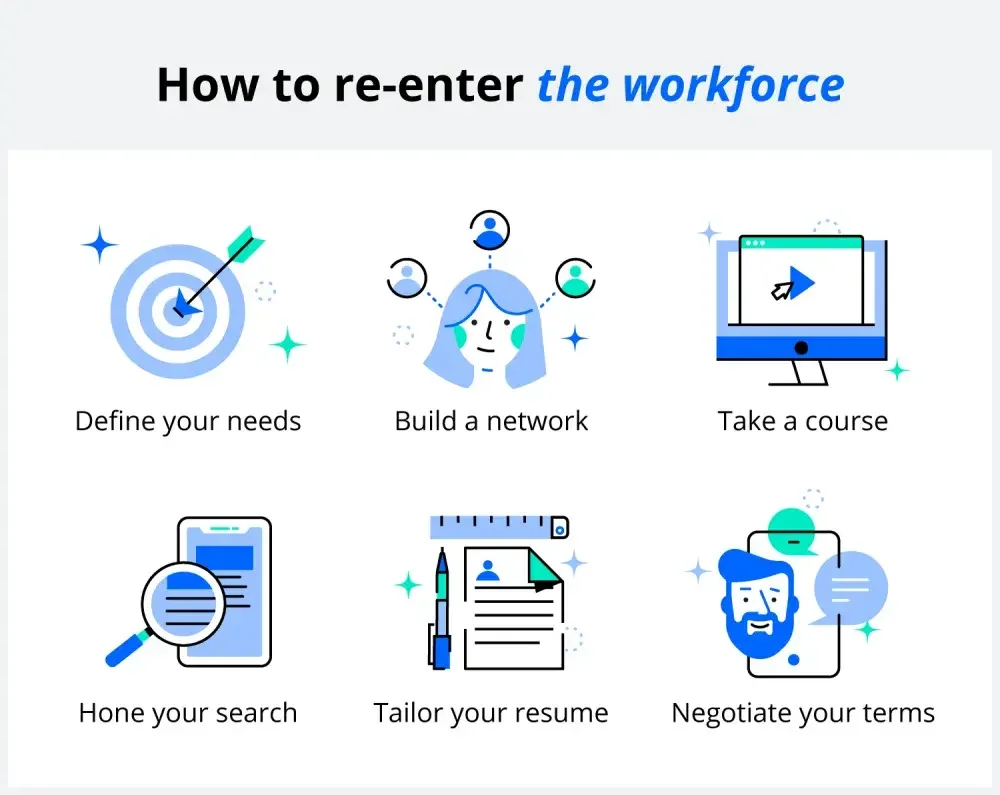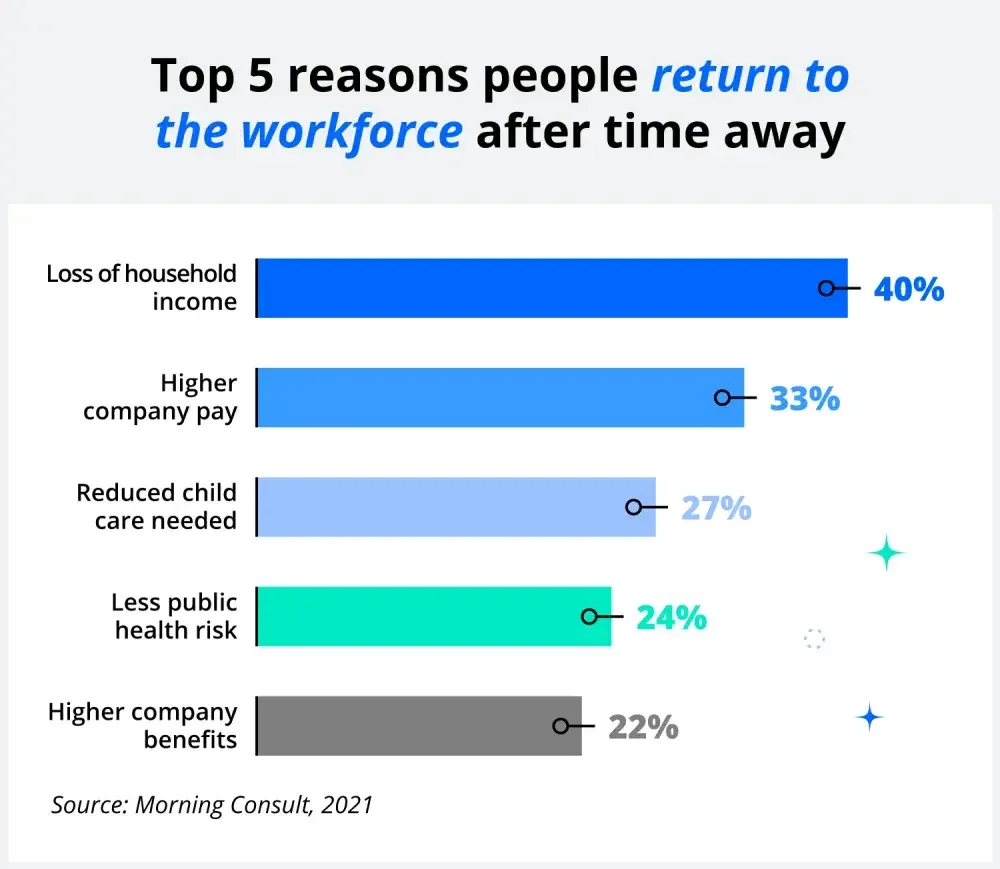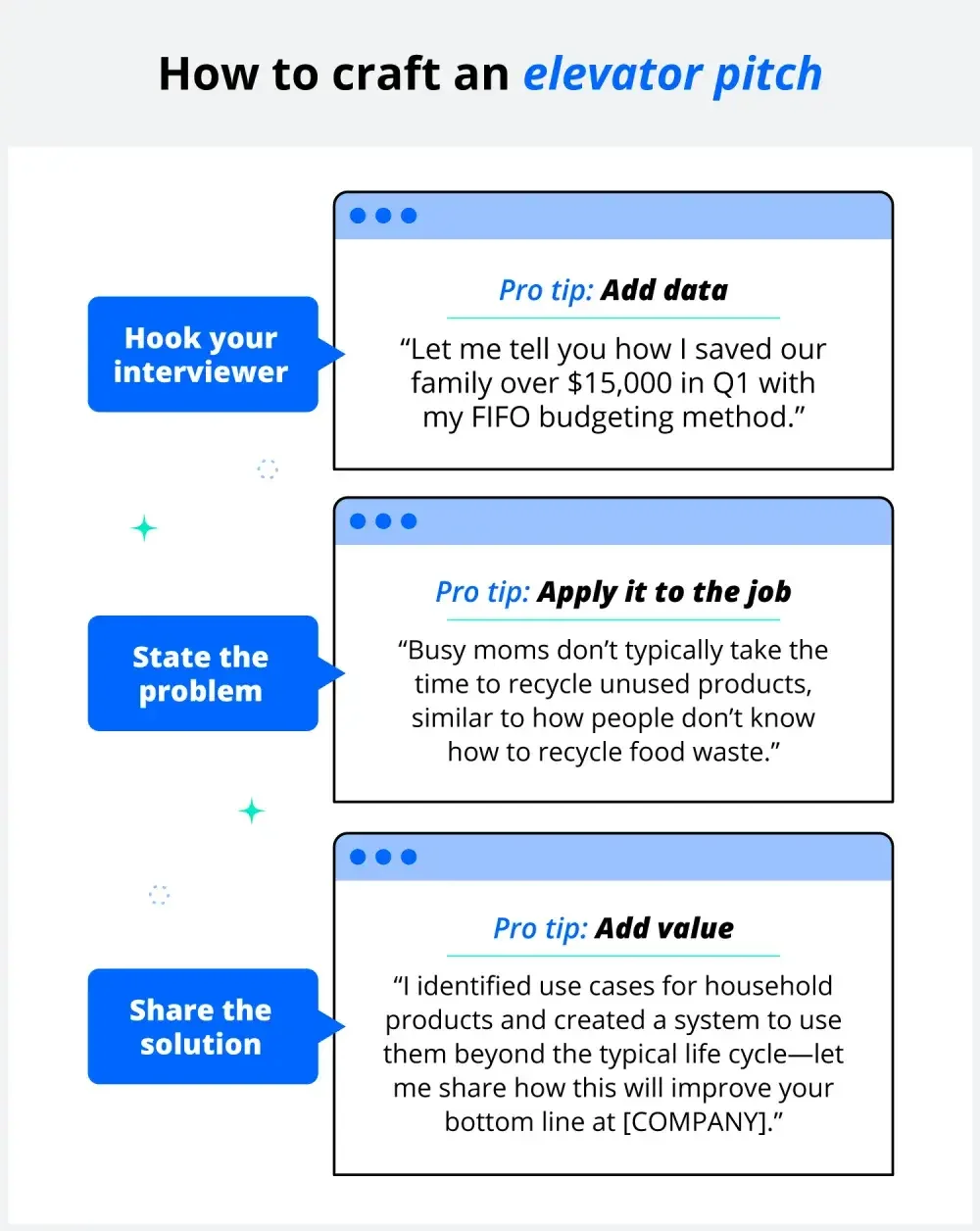Employment gaps can happen for any number of reasons. Whether you took time off for childcare, travel, to start your own business, or anything in between—re-entering the workforce is not only possible but more common than ever.
Here are some tips for getting reacquainted with the hiring process.
How to get back into the job market
If you're feeling overwhelmed by re-entering the workforce, use the simple steps below to evaluate your current situation and communicate your direction clearly.
- Define your situation: Concentrating on exactly what you want in a new job will help make your job hunt more efficient. Adjusting to a full-time job can be challenging, so consider what type of work suits you best, such as hybrid, remote, part-time, full-time employment, contracting, freelancing, or starting your own business.
- Build your network: Let people in your network know you're looking for work. Leverage your existing relationships to find referrals and advice. If you don't have professional connections, reach out to a recruiter or career coach to help support you in re-entering the workforce.
- Take a course: Technology creates rapid changes in many industries. Before applying for a new role, refresh your knowledge and learn something new with online certifications, courses, and data from industry leaders.
- Hone your search: Use filters on job search engines to tailor your pursuit. Apply filters for geographic region, compensation, type of role, title, and industry.
- Tailor your resume and cover letter: Consider spending time creating different resumes for different roles and industries you're applying for.
- Negotiate what's important: Consider what's most and least important in your next role, such as flexibility, time off, growth, or compensation. Discuss with prospective employers early on to avoid interviewing for roles that aren't a fit.
- Review and sign the employment agreement: Before signing a legally binding employment agreement, communicate any changes needed with your prospective employer when the offer is given.
Remember that your talents and interests may have changed since your last professional role, and it's crucial to honor your values in your new role for longevity at your prospective company. While a one- or two-month gap is typical in a resume, six months or longer may require you to move through the steps above.
Common interview and job search etiquette tips
Whether you're re-entering the workforce after a long break or you're a seasoned employee, etiquette in your job search is essential. Consider the following when looking for a new role:
- Be on time: Be mindful of interviewers' busy schedules and be a few minutes early for scheduled calls, video conferences, and in-person interviews.
- Refresh your references: Notify your references ahead of your job search, including dates you worked together and the type of role you're looking for so they're not caught off guard—especially if it's been a while since you last worked together.
- Do your research: Be ready for the interview by researching the company and person you're speaking with ahead of time.
- Say thank you: Gratitude goes a long way. Thank your network for giving you insights into the job market, recruiters for their efforts, and interviewers and prospective employers for time spent speaking with you.
Beyond the basic job etiquette tips above, consider reviewing your social media profiles and cleaning up nonprofessional photos and copy before continuing with the steps to return to work after a long absence.
Steps to return to work after a long absence
Whether you're returning to the workforce to take advantage of higher pay and benefits or because your life situation has changed, you're not alone.
Many parents, especially mothers re-entering the workforce, feel similarly about returning.
Consider how your situation may have changed since you were last in the workforce and prioritize your needs. Clearly define what job components are most important to lessen the risk of your new position not being a good fit.
Start your career search by researching what's changed in your industry of choice, then use the following six tips to return to work:
1. Request a letter of recommendation
2. Update your resume
3. Create an elevator pitch
4. Send a job acceptance email
5. Send a job offer rejection letter
1. Request a letter of recommendation
Many job applicants rely on letters of recommendation in today's competitive business market. If you're a job applicant, a letter of recommendation can help you gain an advantage in hiring.
Learn how to write a request for a letter of recommendation. There are several steps involved in requesting a recommendation, including:
- Finding a co-worker or employer who is familiar with you, your achievements, and your work ethic
- Sending your contact a request for an employment reference letter.
- Giving your potential reference access to your resume, accolades, and a copy of the job description
- Sharing a reasonable turnaround time to sign and send the recommendation
Whether you have an online service provider, help write a letter of recommendation, or allow your reference to write their own, make sure the letter is between one and two pages and tailored to your specific situation.
The format for a recommendation letter should include:
Introduction
- Your reference's business letterhead and the address of the company
- Your reference's contact information
- The date the letter was written
- A professional greeting such as “Dear Hiring Manager"
Body
- Should include keywords used in the job description to describe your skills and character
- Specific data about results with the company, like improving sales by a certain percentage
- The amount of time your reference has known you and worked with you
Conclusion
- A strong recommendation for hire
- A professional closing such as “Sincerely"
- Your reference's signature and job title
When done properly, a letter of recommendation can help give you an advantage over your competition.
2. Update your resume
When writing or updating your resume after extended time off, be honest about your gap while using strategies to communicate why you're qualified. Highlight transferable skills gained during your time off, such as:
- Volunteer work
- Courses or certifications
- Open educational resources (OERs)
- Open access resources (OARs)
- PTA or HOA membership
- Soft skills (parenting, for example, requires maintaining composure in high-stress situations)
Your resume should reflect storytelling, authenticity, human connection, and data. Using numbers to quantify your previous role shows how your specific accomplishments impacted organizations without bias.
3. Create an elevator pitch
Once you land an interview, you need a hook to build interest and a connection with your potential employer. Enter: the elevator pitch.
An elevator pitch is a short speech you can give to potential employers about your experience and the desire to get back to work.
Prepare a 30-second introduction of yourself highlighting snippets of your most notable professional experience. Speak with confidence about how your skills can make an impact on the prospective employer—bonus points for using data to communicate value.
Beyond your elevator pitch, rehearse your responses to common interview questions, such as what you did during your employment gap and why you're ready to re-enter the workforce at this time. Keep your explanation concise and authentic.
4. Prepare for background checks
When employers hire employees, they verify information on candidates' resumes. Employers are required by the Equal Employment Opportunity Commission (EEOC) and the Federal Trade Commission (FTC) to obtain consent via an employee release of information form before conducting these checks.
An authorization to release employee information may cover various types of background checks, including:
- Educational background
- Employment background
- References
- Criminal background
- Credit report
The extent of a background investigation depends on the nature of the position. For most positions, confirming your education and employment history is sufficient.
A credit report isn't usually obtained unless the employee will work in a position dealing with money. Strong credit history indicates to employers that you're responsible and has a positive impact on your job application. If negative credit history affects your job application, you'll receive notice that your credit history triggered the denial in an adverse action letter.
Learn how to respond to an adverse action letter with inaccuracies and mistakes below:
- Input a formal dispute: Each bureau has specific instructions on its site for where and how to report mistakes.
- Write a statement: The statement to the bureau should describe both the inaccuracy and the actual correct information, including supporting evidence.
- Allow time for an investigation: The bureau has 30 days—45 if you provide supporting evidence—to investigate and respond to your request. The bureau will remove items if they can verify the mistake.
- Get the results: The bureau will notify you of the results and provide another free copy of your credit report. Request they send a notice of correction to anyone who requested your report within the last six months.
Even if you don't intend to submit a job application whose acceptance depends on credit, checking your credit report from all three bureaus every year allows you to spot errors and correct them before they result in a denial or hurt your credit.
5. Send a job acceptance email
Let's say you've just received an offer for a job you interviewed for. While your employment only becomes official when you sign the employment contract, writing a job acceptance letter helps set a polite and professional tone with your new employer.
Be sure to carefully read through the job offer before sending a job acceptance email or signing the employment contract. If the offer includes a description of the job, make sure it's the position and title you interviewed for. Even if it's your dream job, consider aspects such as the salary, the start date, and benefits—including vacation time.
Once you've decided you want to accept the job, write the acceptance letter. Your letter should contain:
- Gratitude for the job offer
- Reference to the position you've been offered
- Your formal acceptance of the position
- The details of the accepted offer, including your starting salary, start date, any benefits such as vacation time, and any changes based on your negotiations
Sending a clear and concise job offer acceptance letter formalizes your confirmation and allows you to put your best foot forward in your new role.
6. Send a job offer rejection letter
You may receive an offer for a job you interviewed for, but upon reflection realize it's not the right fit for you.
There's always the possibility that the company might be a better fit for you down the road, so it's best to not burn bridges. The most professional way to handle the situation is to write a job offer rejection letter.
A professional job offer rejection letter is concise and contains only what's needed to let the company know you're not taking the job.
In the letter, thank the interviewer for their time and for offering you the position. Highlight any positives about your experience. Explain why you're not taking the job without giving too much detail.
Common reasons for offer rejection letters include:
- Insufficient salary or benefits
- Inconvenient job location, especially if you thought it would be at a different office
- You received a better offer from another company
- Family issues that interfere with taking the job at this time
- The job isn't a good fit for your skills
- The job offer is not for the position you expected
- The work hours aren't convenient
Avoid anything negative such as:
- Disliking the company, its policies, or the employees
- The role isn't the right fit
- The office isn't in a neighborhood where you want to work
In the case that you decide to turn down a job offer after accepting it, the hiring manager should know as soon as possible.
No matter why you're turning down a job, sending a well-written rejection letter indicates that you're a professional who might be worthy of consideration for future positions.
Re-entering the workforce: FAQ
Taking time off from work, whether it's for maternity leave, to care for a sick family member, or for other personal situations, can make re-entering the workforce daunting. Below are common questions and answers around the topic of re-entering the workforce so you can do so with confidence.
What is re-entering the workforce?
Re-entering the workforce is the process of searching for a new career after an extended leave from paid employment.
How can a stay-at-home mom re-enter the workforce?
Returnships, or internships for adults who have been out of the workforce, and other return-to-work programs are simple ways for stay-at-home parents to re-enter the workforce without the pressure that can come with transitioning back into a full-time opportunity. Other ways are to refresh your skill set by taking a course, or dip your toes into paid work through freelance opportunities.
How do I get back into the workforce at 50?
Leverage your prior experience if you're re-entering the workforce later in life and connect with your existing network for potential opportunities. It's never too late to acquire new knowledge with courses, certifications, and industry news to return to work after a long absence.
How do I get back into the workforce after 5 years?
One way for seasoned employees to re-enter the workforce after a gap is to create a bridge job. This can include freelancing, consulting, contract work, or volunteering. Bridge jobs allow you to set flexible hours and level up your skills before returning to a full-time role.
What if I receive a notice of adverse action?
Under the Fair Credit Reporting Act (FCRA), the notice of adverse action must include:
- Which of the three credit bureaus was used, and its contact information
- Your credit score, if it was used in the decision
- One or two factors that impacted your credit score, if your credit score was used
- How you can obtain a free copy of your credit report within 60 days of the notice
Once you receive an adverse action letter, you have 60 days to request a free copy of your credit report from the credit bureau and have the opportunity to correct errors.
Review your name, Social Security number, date of birth, and other personal information on the report. Next, check for mistakes, including:
- Bankruptcies that are still listed after the 10-year limit
- Negative entries that occurred more than seven years ago
- Payments you made on time that are reported as late
- Credit limits or loan amounts that are incorrect
- Incorrect account balances
- Accounts reported as past due when they are actually up to date
- Accounts that are not yours, such as those of a spouse, family member, or someone else with your same or similar name
- Accounts that were included in bankruptcy but are still listed
- Duplicate accounts
- Inquiries, collections, or accounts you never applied for that are the result of fraud or theft
No matter the reason for a career break, re-entering the workforce after a long absence can feel challenging. It's crucial to prepare properly before making this transition. Tap into your network to find new opportunities and advice. Reflect on what your goals are with your new career. Review and update your resume with new skills you developed during your time off.
If you started your own business, that's a career in itself, and you should analyze how you can communicate those gained skills to a prospective employer.





